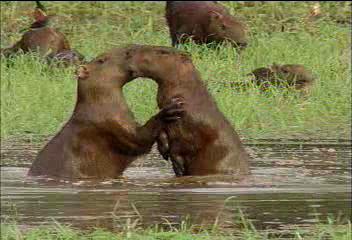One can see in the western plains rainy center of Venezuela but it is in all latinoamérica. The chigüire is the rodent but big of the world and it belongs to the species of the caviomorfos. Also called capibara or Rodent carpincho and it weighs 50 Kg but it can end up weighing 80. According to some this species this in extinction and according to other it is very preserved.
These rodents usually live since in mainly inhabited communities for females there are 2 for each male. These social groups are governed under a hierarchy of a dominant male. To maintain their position, this it pursues another subordinate male which gives semicircles to the flock for not abandoning them. A particularity of these males is that they never abandon the group. And any intruder is expelled without distinction of his sex.
Their communication is mainly based in the chemical signs that produce its two glands. A he/she calls himself morrillo and it is in an oval protuberance on the muzzle of the males. It is believed that this gland indicates the social state because to the dominant male it is who but it uses it, thanks to this he/she has it very developed. The other gland is in the anus of both sexes for what is thought that it is to distinguish to the mienbros of the group.
The chigüire also derefugiarse in the water, feeds in her and it regulates its corporal temperature. As they are vegetarian they usually eat grass or species of aquatic or semi-aquatic plants because they live near rivers and lagoons.
The chigüire reproduces in a dry time: summer. On the other hand the males but big they are those that have but success in the reprducción and it is believed that the conditional better females physically will have but males that females. The females have a period of gestation of 150 days and they usually have per annum from 1 to 2 litters of 4 breedings each one.

Once the breedings are born they have little time before feeding of grass for what the mothers don't care to have to breastfeed a breeding that is not his.
As duty of the group they also have to take care of the breedings that stay together until the first year. Then it happens the dispersion in which a male subordinate sa also goes accompanied by several youths and the females.
The chigüire in Venezuela
The Chigüire is in the plains, the Orinoco, the Delta, Guiana, Windward, the state Miranda, in the Lake of Valencia and in the plains I center occidentale. And in the basin of the Lake of Maracaibo he/she inhabits a variety of this rodent that one knows locally as piropiro.
At the moment, the populations of chigüire of the oriental plains have been severely shrunk while those that are located in the delta of the Orinoco and in the region of Guiana they stay stable and those of the flat inundables center Westerners are abundant besides the private country properties the hunt is not allowed, that which helps enough.
In Venezuela, the chigüire is one of the three animals protected by means of the Plan of natural populations' commercial use implemented by the Ministry of the Atmosphere through the Direction of Fauna Silvestre.
This plan also benefits to the dribbles, crocodile species, and to the psitácidos (parrot guaro, real blue-yellow guacamayas and red belly), but the chigüire was the pioneer, being applied on this species from 1968.
The Venezuelan habit of eating their meat in the religious festivities of Week Santa it has transformed to the chigüire into a commercial value animal, for what the interest of the farmers in its conservation has been increased, allowing the successful application of this program.
Now the study of the behavior of the Chigüire has been facilitated thanks to this initiative and its populations recover quickly.
Hopefully this type of programs extends on other species that you/they are the one in danger of disappearing.
